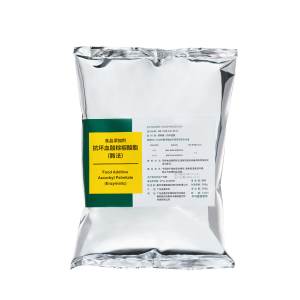Ascorbyl Palmitate
Ascorbyl Palmitate / CAS : 137-66-6
| Appearance | White to light yellow powder | UN | - |
| HS | 29362700 | DG Class | - |
| Synonyms | Vitamin C Palmitate; Palmitato de Ascorbila; L-Ascorbyl 6-Palmitate; Palmitate Vitamin c; L-Ascorbyl Palmitate; AP; L-AP; (S)-2-((R)-3,4-Dihydroxy-5-Oxo-2,5-Dihydrofuran-2-Yl)-2-Hydroxyethyl; Palmitate; Scorbic; Ondascora; 6-O-Palmitoyl-L-Ascorbic Acid; [(2S)-2-[(2R)-3,4-Dihydroxy-5-Oxo-2H-Furan-2-Yl]-2-Hydroxyethyl] Hexadecanoate; Antioxidant Ascorbyl Palmitate; Ascorbly Palmitate; MFG OF Ascobic Palmitated; Ascobic Palmitated | ||

- Email: huangtao@mail.chemball.com
- Whatsapp: 0086-15381053599
- Tel: 0086-571-8627 3270
latest price
Overview
Benefits
The world's only Ascorbyl Palmitate produced using enzymatic production process has zero pollution, zero emissions, and is not easy to produce by-products during the production process
Specification
Test Item | Specification | Method | |
Appearance | White or yellowish-white powder | BP2022, NF2021,FCC12 | |
Identification | Specific optical rotation | +21° ~ +24° | BP2022 |
Infrared absorption | Consistent with the CRS | BP2022, NF2021,FCC12 | |
Color reaction | The sample solution decolorizes dichlorophenol-indophenol TS | BP2022, FCC12 | |
Chromatographic identity | The retention time of the major peak of the Sample solution corresponds to that of the Standard solution | NF2021, FCC12 | |
Appearance of solution | Clear, less intense than BY4 | BP2022 | |
Specific optical rotation | +21°~ +24 | BP2022, NF2021,FCC12 | |
Lead | NMT 2 mg/kg | FCC12 | |
Melting range | 107~ 117C | FCC12 | |
NMT 1.0% | BP2022 | ||
Loss on drying | NMT 2.0% | NF2021 | |
NMT 2% | FCC12 | ||
Sulphated ash | NMT 0.1% | BP2022 | |
Residue on ignition | NMT 0.1% | NF2021,FCC12 | |
Residual solvent | NMT 0.5% | NF2021 | |
Assay | 98.0%- 100.5% | BP2022 | |
95.0%~ 100.5% | NF2021 | ||
NLT 95.0% | FCC12 | ||
Additional testing | Odor | Without caramel smell | In-house |
Thermo tolerance | Not more intense than BY4 | In-house | |
Solubility | Very sightly soluble in cold water | USP 40 | |
Heavy metals | Lead | ≤0.5 mg/kg | AAS, in-house |
Cadmium | ≤0.5 mg/kg | AAS, in-house | |
Arsenic | ≤0.5 mg/kg | AAS, in-house | |
Mercury | ≤0.1 mg/kg | AAS, in-house | |
Microbials | Total Aerobic Microbial Count | NMT 100 cfu/g | ChP2020 |
Total Yeasts and Moulds Count | NMT 10 cfu/g | ChP2020 | |
E. Coli | Negative | ChP2020 | |
Salmonella | Negative | ChP2020 | |
S. Aureus | Negative | ChP2020 | |
Uses
Fat-soluble antioxidant: L-ascorbyl palmitate is a fat-soluble antioxidant that can clear lipid peroxides in the body, preventing oxidative damage to cell membranes, fats, and cholesterol by free radicals. Therefore, it can be used to prevent and slow down aging and the development of diseases.
Health supplement material: L-ascorbyl palmitate is widely used as a material for health supplements because it can improve immunity, improve skin quality, and reduce blood lipids and blood sugar.
Cosmetic material: L-ascorbyl palmitate is widely used in cosmetics, especially in anti-aging and whitening products, due to its antioxidant and whitening effects.
Pharmaceutical adjuvant: Studies have shown that L-ascorbyl palmitate can be used as an adjuvant drug to kill Helicobacter pylori. H. pylori is a pathogenic bacterium that causes gastric ulcers and gastric cancer. L-ascorbyl palmitate can prevent the growth and reproduction of H. pylori by lowering the pH value of gastric juice.
Picture
Properties
Summary
Attribute classification
Food(Feed) Additives > Antioxidants
Food(Feed) Additives > Nutritional Fortifier






























